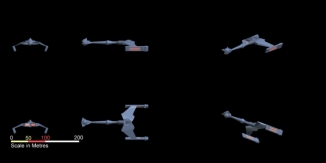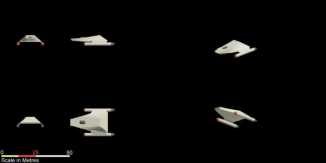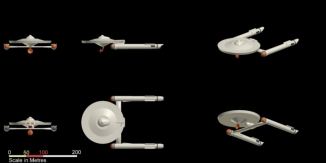Details to follow
Renumbered from D-4 to fit FASA system.
| Class: | XIX | Year: | 2240 | |
| Ship Source: | Titan Fleetyards | Ship Datasheet: | Coming Soon | |

Details to follow
Renumbered from D-4 to fit FASA system.
| Class: | XIX | Year: | 2240 | |
| Ship Source: | Titan Fleetyards | Ship Datasheet: | Coming Soon | |

The Ptolemy class transport was the first in a line of successful high-load warp transports used by the Federation. Equipped with specially designed warp engines suitable for towing mass never before realized, the vessels were a boon to infrastructure building outside the core of the Federation. Initially, production contracts called for 30 ships of this class to be constructed. However, due to the fleet-wide ship build-up at the time it was commissioned, limited appropriations permitted the construction of only 15 of the class.
The Ptolemy class was designed for easy and efficient transporting of cargo within outboard cargo containers. The cargo containers were easily attached and detached via a specially designed coupling unit fitted to the neck of the primary hull of the starship. Depending upon total mass, up to two containers could be towed by the Ptolemy at one time. These containers were mass-produced and supplied to both Starfleet and private shipping concerns (at a reduced rate) to promote the use of these standardized containers. Practically a ship unto themselves, these containers were a break-through in shipping technology just as the high-load warp engines mounted on the Ptolemy were.
The containers came in five basic types:
The Mk I-III and V containers had their own cargo transporters (up to six), turbolifts for carrying goods to various levels and self-contained environmental machinery. The Mk IV containers also included 6 personal transporters and could accommodate 800 passengers. This container also had its own sensors array, was capable of sub-light speed and could sustain its passengers in case of an emergency for up to 18 years.
During the Four Years War, an urgent need arose for military cargo transports. Because of their slow speeds, the Ptolemy was not a viable candidate. However, the need was so great that all Ptolemys in service at the time were converted to Mk IIs. The Mk II mounted the FWB-1 engine which improved the speed of the transport, but at the cost of limited cargo capacity. The Mk II could only carry approximately 121,000 mt of cargo in smaller outboard cargo containers. However, this was sufficient in its role as a military transport.
After the Four Years War, surviving Ptolemys were retrofitted with the FHLWA-1 and returned to their pre-war roles. Many of the Mk IV containers were converted to starliners, with luxurious accommodations for up to 500 passengers. These starliners contained a park promenade, numerous recreation lounges, 2 full theaters, a gymnasium, pool and hydroponic gardens.
This modified version was first built in 2242 alongside the standard version, it featured more discreet hull mounted deflectors as opposed to the large dish of the standard ships. Post war most of the class were converted to this standard, which gave no performance benefits, but considerably improved reliability.
| Class: | VII | Year: | 2242 | |
| Ship Source: | Starfleet Technical Manual/The Starfleet Museum | Ship Datasheet: | Download PDF |



The first encounters with the L-6 frigate came during the Four Years War. Though few of them were met in actual battle, those that did were usually victorious; none was ever captured and only three were destroyed.
In 2252, in an engagement that was to typify all subsequent encounters with these vessels in the war, two Larson class destroyers and a Loknar class frigate were bludgeoned by a single L-6. The destroyers Eylau and Jutland were patrolling the outer fringes of the Falgor system, left behind with the frigate Proxima when the main body of the Federation fleet withdrew to reform and ready itself for the inevitable Klingon thrust. The destroyers encountered the L-6 as it entered the area, readied themselves for combat, and dispatched a message to the Proxima requesting assistance. The Jutland called for the Klingon vessel to surrender as it approached. The L-6 responded by firing on the Eylau, damaging its impulse drive system. The Jutland closed to extreme range and opened fire, but the damage it inflicted was negligible. While the Klingon ship was concentrating on the incoming Jutland, the Eylau managed to damage a warp engine, causing the L-6 to turn on the Eylau with a withering barrage, destroying the Eylau’s warp drive controls and causing it to go dead in space. Once again, the Jutland fired to minimal effect, and the L-6 renewed its fire on the Jutland, which was no match for the Klingon frigate either in terms of firepower or range. The Jutland received one damaging blow after another, all from extreme range for its weapons. When the L-6 eventually closed for the kill, it was frustrated by the arrival of the Proxima. Approaching the Klingon from the rear, the Proxima closed rapidly and delivered a devastating blow to the engineering section, only to be surprised by the Klingon’s aft-firing disruptors, which delivered a volley into the bridge and forced it to withdraw. Luckily for the Federation vessels, the moderately-damaged L-6 decided to withdraw, leaving the Eylau damaged beyond repair, the Jutland severely damaged, and the Proxima lightly damaged.
The L-6 went through an interesting change around 2268, when the warp engines were changed from the KWD-1 to the KWE-1, and the impulse system was upgraded to the more powerful KIE-2. The warp engines delivered less power than the earlier designs but were more efficient. The impulse system increased its power output over the earlier system by 600%. The overall output of power decreased, however the maneuverability increased. Further changes included the addition of more troops and shuttlecraft as well as improved weaponry and shields. This modification did not alter the basic weakness in the L-6 design, its amidships warp engines.
Of the approximately 300 L-6s built, about 230 remain in active service and about 50 have been destroyed; the disposition of the remainder is unknown. Operation Dixie reports indicate that the L-6 is produced at the Kodal facility. The class name is translated from the Klingon th’lar.
| Class: | VIII | Year: | 2247 | |
| Ship Source: | FASA | Ship Datasheet: | Coming Soon |

Of the 192 D-16s built, 27 are in reserve fleets, 123 have been destroyed, 11 have been captured (6 by Star Fleet, 4 by Romulans and 1 by Orions), 8 are listed as missing, 3 have been scrapped, 16 have been sold to ranking and prominent families in the Empire, and 4 have been sold to private interests within the Triangle. The D-16, named from the Klingon kisarza, was produced at losia.
|
|
||||
| Class: | VI | Year: | 2245 | |
| Ship Source: | FASA | Ship Datasheet: | Coming Soon | |


The D-4, predecessor to the famed D-7 class, pioneered the modern iteration of the command pod forward design that has become the standard for most modern Klingon warships. The class was introduced in 2239 with the commissioning of eight ships, which had been produced at the alarming rate of one per month at facilities operating as if under wartime production orders. This was a clear signal that the Klingons were either preparing for a war with either Romulan or Federation forces or were involved in a conflict along an unknown border. Only recently, because of intelligence gained from Operation Dixie, has it come to light that the Klingons were in fact being attacked by an unknown enemy along their coreward border. During this conflic the D-4 saw extensive action and went through several different modifications, many of which were never brought into production. This conflict ended somewhere around 2241, slowing further development.
In 2249, the D-4E was tested and proclaimed successful. Production was converted over to this newer model, and, by Stardate 1/9203, the first vessels were commissioned. By 2253, the D-4A was no longer being produced, and most of the D-4A’s in service were being converted to D- 4E’s, which mounted a more powerful impulse drive system.
The major improvement was the replacement of the KD-2 by the KD-3, with a range of 120,000 km, extending the offensive capability of the D-4 by 20,000 km. The shielding system was also upgraded, with the new KSE system giving the ship 65% more protection from incoming fire. The superstructure was strengthened to handle the uprated equipment. Even though the D-4 proved to be valuable in combat, witnessed by its class name of “Predator” from the Klingon “d’ama”, its days were numbered. The D-7, with its higher firepower and more powerful engines, would replace it by 2266.
Of the 814 D-4’s built, 277 are in reserve fleets (48 A’s and 229 E’s), 462 were destroyed, 14 have been captured (3 A’s and 6 E’s by Star Fleet and 2 A’s and 3 E’s by the Romulans), 6 reported as missing, 16 were scrapped, 11 sold to the Orions (4 A’s and 7 E’s), and 28 sold to prominent families of the Empire (10 A’s and 18 E’s).
| Class: | VII | Year: | 2239 | |
| Ship Source: | FASA | Ship Datasheet: | Coming Soon | |


The Mission-X was ordered by Starfleet Intelligence Command in 2248. Externally identical to the standard Mission Class scout/courier, the Mission-X had a combat capability greater than many destroyers and cruisers. The major drawback of the design was the high cost of fitting such components into a small hull. Additionally the design compromised the crew facilites and fuel storage, making missions of more than seven days duration impossible.
Prior to the Four Years war the ships were primarily used in Intelligence gathering duties along the border away from the glare of publicity. But war changed that, as some of these ships were stationed at what became known as ‘Malta Station’ which was beseiged by Klingon Forces for much of the war. The ships assigned to that station earned Federation wide fame for their brave actions supporting the defence of the station. These four ships ‘Faith’, ‘Hope’, ‘Charity’ and ‘Desperation’ collectively destroyed 34 Klingon Vessels, and crippled a further 46. Starfleet refuses to confirm whether the original four ships survived the war, or whether they were secretly replaced during the war after being destroyed.
30 Mark 1 ships were built, and 20 new build Mark 2s. The 18 Surviving Mark 1 vessels were uprated to Mark 2 standards, the only difference being the FWA-2 engine installation.
2256 saw the testing of an enhanced Phaser and Photon Torpedo armed Mark 3 version. This ship was marginally less combat effective than the Mark 2 and more expensive to build. Only the prototype vessel was built of this mark as it was clear that the earlier ships were still highly effective. The Mission-X class was finally withdrawn from service in the 2280’s, it was the last FL/FAC Armed ship on the active service list. Rumours do persist though of special variants still serving with Intelligence command, but these cannot substantiated.
| Class: | III | Year: | 2248 | |
| Ship Source: | FASA/Steve Bacon | Ship Datasheet: | Download PDF | |



When most citizens of the Federation think of the ships of Starfleet, their thoughts may soar with the mighty designs of the Constitution ,Enterprise and Excelsior classes. However, one of the most successful and influential designs in the history of the Federation is the modest Mission class. This versatile little ship will forever be linked to the success of the Federation in many ways.
| Class: | II | Year: | 2248 | |
| Ship Source: | FASA | Ship Datasheet: | Download PDF | |



The Pompey Class was conceived as a light twin engine Destroyer variant of the successful Hermes Class Scout. The change to a twin engine layout improved the available power and manoeuvrability, however compromises in the Tactical system made the initial variant not wholly satisfactory, and an improved Mk 2 was soon introduced.
The Pompey never gained wide acceptance in service, and the later Saladin variant of the Hermes class displaced it from front line service. The Pompey continued to be used in longer duration missions in remote regions as the twin engine design was felt to be more robust than the single engined Saladin.
| Class: | VI | Year: | 2243 | |
| Ship Source: | Mastercom Data Center (Corrected schematics supplied by Aridas Sofia) | Ship Datasheet: | Download PDF | |


“The Stellarford II (Mk4) was an attempt to restart production using new technologies in the shape of the FWH-1 warp drive. However only five new build ships were completed before the shipyard went bust due to the high costs of building the class compared to newer modular vessels, a further hull was abandoned while 60% complete. These five ships were procured by Mars shipping as part of the civilian reserve fleet program, which saw Star Fleet underwrite a proportion of the cost of acquisition of the ships in return for them being made available in times of emergency.
The performance of the Mk4 prompted Star Fleet to offer to underwrite the conversion of Mk3 ships to the standard, again in return for use of the ships in times of war. At the time the conversion of a such a number of large elderly ships was thought to be pointless, but with hindsight it can be seen that it was a perfectly timed program. 20 ships were modified to this mark by 2247, and that was planned to be the end of the program.
Visually, the Mk4 could be easily distinguished from the earlier versions as the short FFTL-3B nacelles were replaced with the much longer dilithium energised FWH-1 nacelles. The more modern construction and materials of the nacelles meant that despite their increased size they massed substantially less, meaning the class reverted to Class IV mass (unladen) and Class VI (Laden).”
| Class: | IV-V | Year: | 2245 | |
| Ship Source: | Spaceflight Chronology | Ship Datasheet: | Download PDF | |


You must be logged in to post a comment.